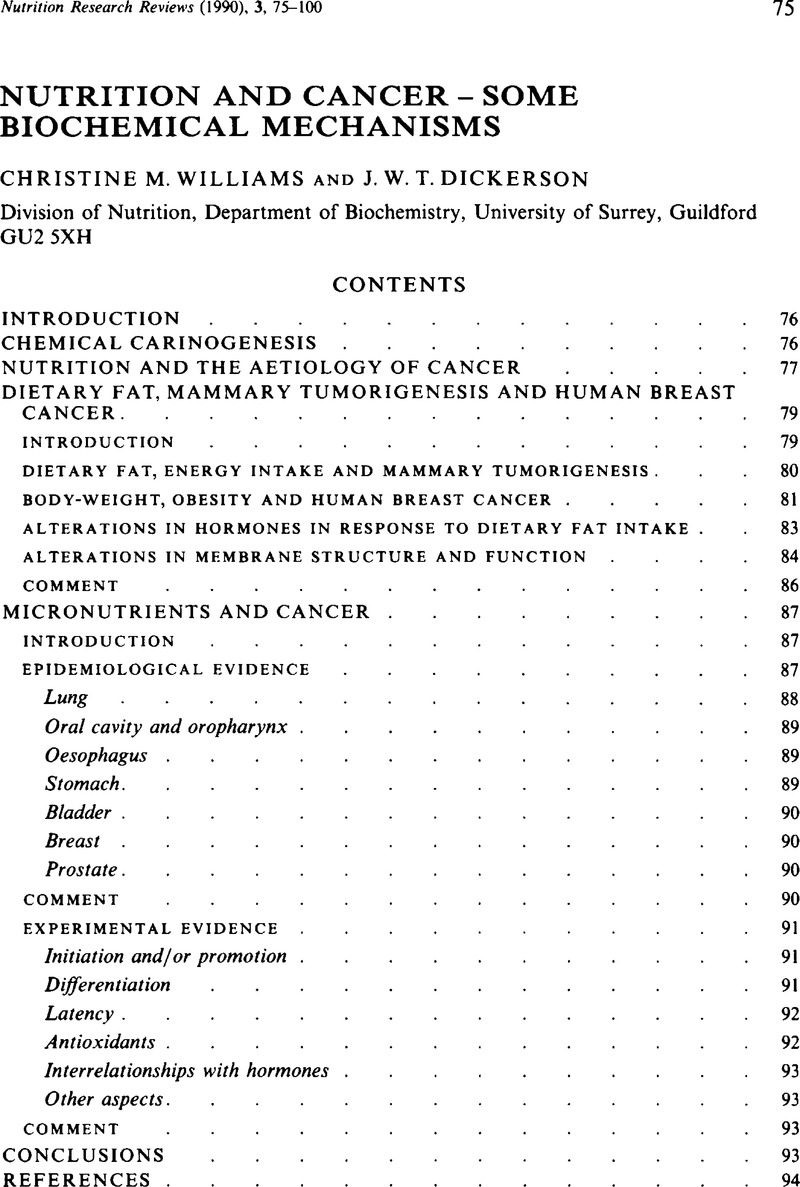Crossref Citations
This article has been cited by the following publications. This list is generated based on data provided by Crossref.
Philip, W.
James, T.
and
Ralph, Ann
1992.
Dietary fats and cancer.
Nutrition Research,
Vol. 12,
Issue. ,
p.
S147.
Ong, Augustine S.H.
and
Tee, E.S.
1992.
Carotenoids Part A: Chemistry, Separation, Quantitation, and Antioxidation.
Vol. 213,
Issue. ,
p.
142.
Tee, E‐Siong
and
Lee, C. Y.
1992.
Carotenoids and retinoids in human nutrition.
Critical Reviews in Food Science and Nutrition,
Vol. 31,
Issue. 1-2,
p.
103.
Diehl, J. F.
1992.
Die toxische Gesamtsituation heute. Gedanken zum WHO-Bericht “Diet, nutrition and the prevention of chronic diseases”.
Zeitschrift für Ernährungswissenschaft,
Vol. 31,
Issue. 4,
p.
225.
Dickerson, J.W.T.
1994.
Scientific Foundations of Biochemistry in Clinical Practice.
p.
1.
Enwonwu, C.O.
and
Meeks, V.I.
1995.
Bionutrition and Oral Cancer in Humans.
Critical Reviews in Oral Biology & Medicine,
Vol. 6,
Issue. 1,
p.
5.
Turrell, Gavin
1997.
DETERMINANTS OF GENDER DIFFERENCES IN DIETARY BEHAVIOR.
Nutrition Research,
Vol. 17,
Issue. 7,
p.
1105.
Taper, Henryk S.
Delzenne, Nathalie M.
and
Roberfroid, Marcel B.
1997.
Growth inhibition of transplantable mouse tumors by non-digestible carbohydrates.
International Journal of Cancer,
Vol. 71,
Issue. 6,
p.
1109.
Martín-Lagos, F.
Navarro-Alarcón, M.
Terrés-Martos, C.
López-G de la Serrana, H.
and
López-Martínez, M.C.
1997.
Serum copper and zinc concentrations in serum from patients with cancer and cardiovascular disease.
Science of The Total Environment,
Vol. 204,
Issue. 1,
p.
27.
Turrell
1998.
Socioeconomic differences in food preference and their influence on healthy food purchasing choices.
Journal of Human Nutrition and Dietetics,
Vol. 11,
Issue. 2,
p.
135.
Taper, Henryk S.
and
Roberfroid, Marcel
1999.
Influence of Inulin and Oligofructose on Breast Cancer and Tumor Growth.
The Journal of Nutrition,
Vol. 129,
Issue. 7,
p.
1488S.
Taper, Henryk S.
and
Roberfroid, Marcel B.
2000.
Nontoxic Potentiation of Cancer Chemotherapy by Dietary Oligofructose or Inulin.
Nutrition and Cancer,
Vol. 38,
Issue. 1,
p.
1.
Montero, P
Bernis, C
Varea, C
and
Arias, S
2000.
Lifetime dietary change and its relation to increase in weight in Spanish women.
International Journal of Obesity,
Vol. 24,
Issue. 1,
p.
14.
Taper, H. S.
and
Roberfroid, M. B.
2002.
Inulin/oligofructose and anticancer therapy.
British Journal of Nutrition,
Vol. 87,
Issue. S2,
p.
S283.
Taper, Henryk S
Jamison, James M
Gilloteaux, Jacques
Summers, Jack L
and
Calderon, Pedro Buc
2004.
Inhibition of the development of metastases by dietary vitamin C:K3 combination.
Life Sciences,
Vol. 75,
Issue. 8,
p.
955.
Benkeblia, Noureddine
2014.
Polysaccharides.
p.
75.



